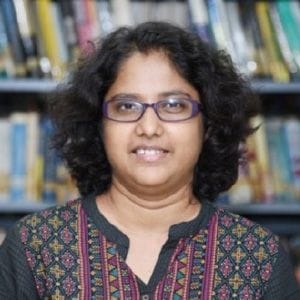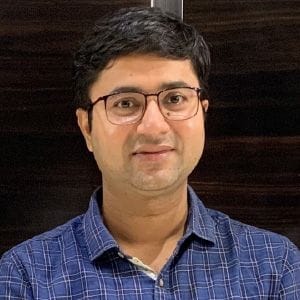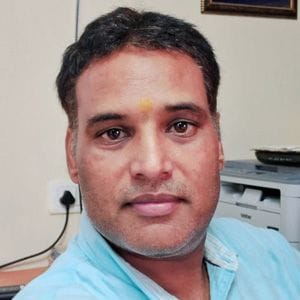We are excited to bring you a collection of exclusive interviews highlighting how open access is transforming the academic landscape for researchers and authors in India.

Open access is pivotal in transforming the academic landscape by enhancing the visibility of research, facilitating collaboration, and ensuring equitable access to knowledge. It allows researchers to share their findings widely, enabling them to reach diverse audiences and drive innovation in their respective fields.
As a dedicated publisher, ACS Publications is committed to supporting your journey in the open access. We offer a dedicated open access microsite featuring free articles, making it easy for you to access valuable research and insights without any barriers.
Our initiatives include offering open access publishing options, promoting transparency in research dissemination, and actively engaging with the academic community to foster collaboration. We believe that embracing open access is vital for nurturing an inclusive academic environment that encourages knowledge sharing and creativity.
In celebration of International Open Access Week 2024, we are excited to spotlight interviews with various influential personalities discussing the significance of open access in India for researchers and authors. Together, we can build a brighter future for research, empower voices, and enhance the collective understanding of our world, making knowledge accessible for all!
Dr. Ramesh L. Gardas

Dr. Gardas is a distinguished chemist and professor at IIT Madras, specializing in Chemical Thermodynamics and Phase Equilibria. He focuses on sustainable solvent systems as alternatives to volatile organic solvents. Dr. Gardas has led 12 major projects, guided numerous Ph.D. and M.Sc. students, and published over 240 research articles. His work has made a significant impact on various industries by exploring sustainable solvent systems with task-specific properties and developing structure-composition-property correlations. He shares his thoughts on open access in the interview below:
Has open access altered the perception of research in your field? In what ways?
Open access has changed how research is viewed in chemistry, especially in India. Before, many important studies were hidden behind paywalls, making it hard for researchers, especially from smaller institutions, to access them. Now, with open access, any interested researcher can download and read the research findings. This has made our field more inclusive, encouraging collaboration among scientists from different backgrounds. It also highlights the importance of sharing knowledge for the public good, rather than just for some privileged groups, making research feel more community-focused.
How has open access impacted the visibility and citation of your research?
Open access has greatly improved the visibility and citation of research. By allowing free access to published research, more people can read them, including researchers, students, and industry professionals. This wider audience has led to more citations, as others can easily reference the published work in their own studies. Moreover, open access articles are often more easily found online, which helps reach an even larger audience. Overall, this has made my research more impactful and has contributed to the growth of knowledge in our field.
What changes would you like to see in the open access landscape to better support researchers in India?
To support researchers in India, I would like to see more funding available for open access publishing. Many good journals charge high fees, which can be a potential discouraging factor for researchers without strong financial support. It would also be helpful to create more local open access journals that focus on Indian research topics. Increasing awareness about open access and how it works is essential, as many researchers may not be familiar with its benefits. Finally, I believe that institutes and government policies should encourage open access publishing for research funded by public money, making Indian research more visible globally.
What resources do you rely on for information about credible open access journals?
To find credible open access journals, I use several key resources. The Directory of Open Access Journals (DOAJ) is a great tool for finding trustworthy journals in various fields. I also look at journal’s various metrics on platforms like Scopus, Scival, Web of science, Scifinder etc. Networking with other researchers through platforms like ResearchGate, Mendeley, ORCID, IRINS (Indian Research Information Network System) etc. helps me get recommendations. Additionally, I stay informed about predatory journals by using resources like Beall’s List to avoid unreliable publications. These tools help me choose the best places to share my research.
Dr. Tatini Rakshit

Dr. Rakshit is an Assistant Professor at the Department of Chemistry, Shiv Nadar Institution of Eminence, Delhi. She holds a Ph.D. from the Indian Association for the Cultivation of Science, Kolkata. She worked as a postdoctoral trainee at Case Western Reserve University School of Medicine and the National Cancer Institute at NIH, USA. She is a chemical biologist. Her research interests focus on mechanobiology, biosensing, bioelectronics, and biomaterials. Read her interview below:
Has open access altered the perception of research in your field? In what ways?
Open access has positively impacted the perception of chemical biology and biophysics research by making it more accessible, increasing the visibility of work, and enhancing the transparency and reproducibility of findings.
How has open access impacted the visibility and citation of your research?
Open-access research is generally cited more frequently than articles behind paywalls, which has helped increase the visibility and impact of research.
What changes would you like to see in the open access landscape to better support researchers in India?
For Indian researchers to fully benefit from the open access landscape, a combination of reduced financial barriers with income-adjusted pricing, institutional membership, and greater institutional and government backing (National OA policies) is needed.
What resources do you rely on for information about credible open-access journals?
When identifying credible open-access (OA) journals, I rely on a combination of trusted resources and guidelines (rigorous peer-review, indexing in Scopus or Web of Science, publisher reputation) that help evaluate the legitimacy and quality of these publications.
Dr. Shibdas Banerjee

Dr. Banerjee earned his M.Sc. in Chemistry from IIT Roorkee, India, in 2008, followed by a Ph.D. in Chemical Sciences from the Tata Institute of Fundamental Research (TIFR), Mumbai, India, in 2014. After completing his Ph.D., he pursued postdoctoral research with Prof. Richard N. Zare at Stanford University in the United States. In 2017, he began his tenure at the Indian Institute of Science Education and Research (IISER) Tirupati, initially as an assistant professor of chemistry, and has since advanced to the role of associate professor. Dr. Banerjee's work primarily focuses on the development of microdroplet-based mass spectrometric methodologies and imaging techniques for chemical and biomedical applications. His research group specializes in the in situ analysis of chemical and biological transformation in real-time and the discovery of disease biomarkers correlating molecular and biological abnormalities. Below, he shares his thoughts on the open science landscape:
Has open access altered the perception of research in your field? In what ways?
Yes, definitely, I believe that's true for any field. My research group is focused on an emerging area called microdroplet chemistry, which has seen rapid growth over the past decade. The broad potential of this field in green synthesis of value-added chemicals, studying reaction mechanisms, disease diagnostics, environmental research, and other related areas should be made open for wider public interest. This would also help attract more researchers to contribute to and develop the field further. Open access will undoubtedly have a significant impact on this area, and I've noticed several articles being published with an open-access mandate. This approach is likely to enhance the accessibility of the research and foster collaboration.
How has open access impacted the visibility and citation of your research?
Open-access publications tend to receive significantly more citations and referrals compared to limited- or restricted-access ones. This is something I've observed firsthand with some of our own work that is openly accessible. For instance, one of our open-access papers has garnered more than a thousand citations over the past ten years, demonstrating the benefits of wider public access, faster dissemination, and increased transparency. The broader reach of open-access research clearly plays a crucial role in enhancing its visibility and impact on developing the field.
What changes would you like to see in the open access landscape to better support researchers in India?
The most crucial change should be the reduction of article processing charges (APCs). The high cost of APCs often restricts early-career researchers or those from underfunded or limited-funded institutions and labs from publishing their work openly. Additionally, some journals may aggressively push manuscripts through the publication process without proper peer review, purely for revenue generation, which can be detrimental to scientific integrity. While such strategies might enhance public engagement quickly, they raise concerns about the transparency and reproducibility of the science being published. These issues could be mitigated in part by offering credit points to reviewers, which could later be used to offset APCs when they publish their own work in the same journal or society journal. This would provide an incentive for thorough peer review while helping researchers manage publication costs.
What resources do you rely on for information about credible open-access journals?
I first consider the journal's impact factor and whether it is indexed in databases like Scopus or Web of Science, as these help gauge the journal's credibility and influence in general (though exceptions might be there). Reputable academic societies, such as the American Chemical Society (ACS), are inherently credible due to their established reputations. Additionally, I rely on recommendations from colleagues and peers to select legitimate and trustworthy platforms for open-access publishing.
Dr. Tushar Sharma

Dr. Sharma is an Associate Professor (Petroleum Engineering) at Rajiv Gandhi Institute of Petroleum Technology (RGIPT), Jais. He received his M.Tech in Petroleum Engineering from IIT-ISM Dhanbad followed by Ph.D. in EOR area (Petroleum Engineering) from Indian Institute of Technology (IIT) Madras. He has also earned his parallel research experience in Thermal-EOR from University of Alberta, Canada. His research interests are in the areas of Carbon Utilization and Storage, Cementation, Nanofluids, and EOR. He has published over 80 technical articles in peer-reviewed International journals and same number of manuscripts in International conferences of repute. He has reviewed several research papers and guided several undergraduate and postgraduate dissertations. Dr. Sharma is also a member of Society of Petroleum Engineers (SPE). Below, he provides insights into the impact of open access in his field:
Has open access altered the perception of research in your field? In what ways?
In my field of work, our outlook towards open access journals has changed significantly as we have come to observe that the quality of research published in them is very good. However, most of the times, research groups like mine are unable to publish in them due to higher Article Processing Charges (APCs). Personally, at times, the APC simply forces me to go ahead with other journals else I do not see any much difference in publishing in Open access or subscription-based journals.
How has open access impacted the visibility and citation of your research?
While there are some stumbling blocks like the APCs which are inhibitive for researchers working in global south from publishing in open access, open Access articles have been observed to have a higher visibility in the research community. Additionally, I have regularly reviewed open access articles and found several of my research group articles in their list of references. The presence of such journals is however very helpful to researchers, who otherwise lack access to subscription-based journals. This keeps them up to date with the latest research findings, being published globally.
What changes would you like to see in the open access landscape to better support researchers in India?
I think there is a possibility to work around the APCs. Perhaps, an opportunity for us to explore models that support activities in line with what the American Chemical Society does for scientific advancement. Volunteers may collaborate or support ongoing ACS activities, maybe in outreach or education or in meetings space, and get APC covered for two-three Open access journals of given choice. Or perhaps some reviewers get a discount while publishing in ACS Publication journals for their reviewer activity.
What resources do you rely on for information about credible open access journals?
I mostly rely on my peer circle to identify credible sources of information, including open access journals. A good metric to gauge credible science being published is where some of the prolific people in my research field publish their work. Furthermore, I regularly rely on updates and my own research to identify emerging journals, including open access journals, that are publishing quality work.
